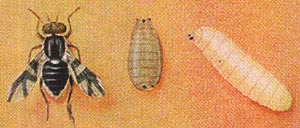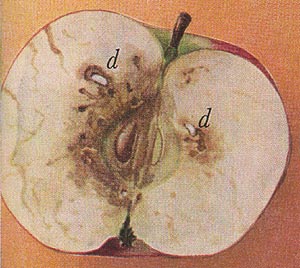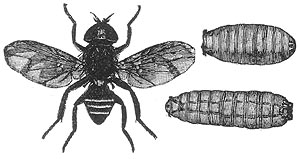


puparium (above right); larva (below right)
BUG OF THE MONTH: May 1999
Apple Maggot
Rhagolethis pomonella
Order Diptera, Family Tephritidae
(Bugs of Wormy Apples, Part 2)
Copyright © 1999 by Louise Kulzer
This article originally appeared in Scarabogram, May 1999, New Series No. 229, p. 2; with additions in June 1999, No. 230, pp. 2-3.
Last month we found out that the codling moth eats the cores of apples, but leaves the apple by eating a tunnel through the flesh. The mature caterpillars then crawl down the tree trunk to spin a cocoon, a fact which can help us control them. Wrapping the trunk with cardboard from mid-summer to fall allows us to fool the larvae into pupating before they get to the bottom. We then destroy the cardboard and the codling moths. This month we'll focus on the other major "worm" pest of apples, the apple maggot.
 |
| Apple Maggot adult, puparium, larva (USDA) |
 |
| Apple with multiple maggots (d) (USDA) |
 |
| Detail drawing of apple maggot adult; puparium (above right); larva (below right) |
As are all maggots, the apple maggot is the immature stage of a fly. The young of the apple maggot are not nearly as well-behaved as the young of the codling moth. The adult flies (nearly the size of a house fly) show up in July and insert their eggs into the flesh of apples. The legless, white maggots eat the flesh throughout the apple, not just the core. Often there are several maggots per apple. Several years ago, most of my apples were infested with apple maggot, and many of my friends had a like experience. In my apples, the maggot damage was more concentrated nearer the core, but the whole flesh was brown and mushy. Not even fit for sauce.
As I mentioned last month, the apple maggot is more of a pest in the Portland/Vancouver area than around Seattle, but it's expected to move slowly north. [And it has! Since this was written, many neighborhoods in the Puget Sound area have a severe apple maggot problem.] Last summer I did not have apple maggots, only codling moth, a fact I was most thankful for. Currently WSU Extension (on their current dial-a-tape) does not recommend spraying for apple maggot in our area - they recommend bringing the fruit in to a master gardener clinic to get a positive ID. Where they are a serious pest, spraying with Diazinon from August to harvest is the recommended chemical control.
Don't despair, though; there's also a non-chemical control the home gardener can use. But first, we need to know a little biology. The apple maggot larvae don't leave the apple and crawl down the trunk like the codling moth caterpillars do. They stay in the apple and simply wait for it to fall, then burrow into the soil and pupate. So by religiously picking up and destroying the infested apples as soon as they fall, you can reduce the number of adults.
Now, when I say "destroy them," I really mean "destroy the larvae in the apple." in doing that, you usually destroy the apple as well. Options include grinding the infested fruit in the garbage disposal or putting it in the trash, assuming it will be collected and taken to Cedar Hills or some other place far away from apple trees. Can you put maggot-infested apples in the clean-green? Now, let's think this through. What do they do with clean-green material? They make compost. Do you think the compost will be hot enough to kill the larvae? Probably, but not guaranteed. Can you home compost them? Same thought process, but I wouldn't do it, no matter how hot a composter I thought I was. Can you feed maggot-infested apples to chickens? Well, will the chickens eat the larvae? Remember, they're smaller than codling moth larvae, and usually there is more than one maggot per apple. Or will your chickens leave part of the apple uneaten? I don't know how ferocious your chickens are. When I had chickens, they didn't seem all that fierce.
Can you feed them to cattle? Same answer, but revolving around how well your cows chew.
You can also buy pheromone traps for apple maggot adults, but it's a bit more complicated than with codling moth. In fact, our own Scarab Tilbury has an impressive set of data about traps she's been using for the last five years against apple maggot, which may be added to this article in the future. Stay tuned! This is some down-and-dirty data you won't want to miss.
Now, just think how much fun you can have this summer when your apples get ripe. You no longer need to grouse about your wormy apples. You can gleefully identify which pest you have! And knowing your pest allows you to better control their population numbers, giving you more worm-free apples. It can also make you the hit of the party at apple cider pressing time.
References
Beers et al., eds. 1993. Orchard Pests. Yakima: Good Fruit Grower Publishing.
U.S. Department of Agriculture. 1952. Insects: the Yearbook of Agriculture. U.S. Government Printing Office, 780 pp.
Wescott, Cynthia. 1953. Garden Enemies. New York: Van Nostrand, 251 pp.
This page last updated 26 July, 2005